Plastic has long been one of the world’s biggest environmental challenges.
From single-use bottles and shopping bags to packaging materials, billions of tons of plastic waste end up in landfills and oceans each year. But what if some of that “trash” could be given a new life? Enter Uses of Plastic Trees, innovative creations that repurpose plastic waste into structures resembling real trees.
While they can never fully replace the ecological benefits of living trees, these artificial counterparts are transforming urban spaces, raising awareness, and reducing the plastic crisis in creative ways.
This article explores the surprising uses of plastic trees, showing how they’ve evolved from being mere decorations to symbols of sustainability and innovation. 🌱♻️
🌱 1. Tackling Plastic Pollution with Innovation
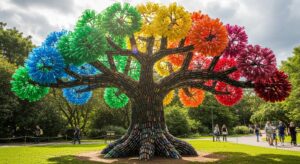
Plastic trees are born out of necessity: the need to find solutions for non-biodegradable waste.
By recycling bottles, caps, and other plastic debris into sculpted tree structures, communities can give waste a second life instead of allowing it to pollute waterways or harm wildlife.
Some eco-projects even build plastic trees in public parks to demonstrate the power of recycling, turning an environmental hazard into an educational tool and art piece.
🏙 2. Urban Beautification and Landscaping
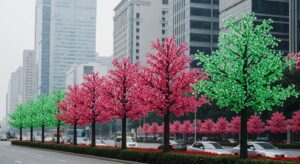
In many urban environments, planting natural trees is not always possible. Harsh pollution, lack of fertile soil, or limited space can prevent real greenery from thriving.
Plastic trees provide a low-maintenance alternative that still delivers aesthetic value. For example:
-
Along busy highways, they offer color without risk of drying out.
-
In shopping malls and airports, they create a calming ambiance.
-
In polluted city centers, they serve as green symbols where nature struggles to survive.
These installations may not produce oxygen, but they do bring a sense of nature to otherwise sterile spaces.
🌞 3. Plastic Trees with Solar Power

One of the most fascinating modern developments is the creation of “solar trees.” These are artificial trees with solar panels integrated into their design.
Instead of leaves, the branches support photovoltaic panels that harvest solar energy. Some models generate enough electricity to:
-
Power streetlights 🌃
-
Charge phones and electric bikes 🔋
-
Provide electricity for rural community centers 🌍
In this way, plastic trees become not only artistic symbols but also functional energy producers.
🎄 4. Seasonal and Decorative Uses
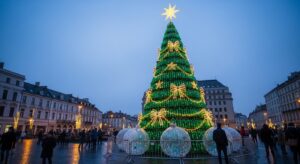
Plastic trees are not new in the world of decoration; think of the millions of Uses of Plastic Trees used worldwide each year. Beyond the holiday season, however, they’re also used in weddings, festivals, and corporate events.
Their reusability makes them more eco-friendly than single-use decorative materials. Plus, they can be customized in size, shape, and color, giving designers endless creative freedom.
📚 5. Raising Environmental Awareness
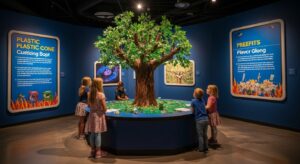
Plastic trees have become educational tools in schools, museums, and eco-parks. By showcasing trees built entirely from plastic bottles, lids, and wrappers, educators can visually demonstrate the scale of plastic waste.
These exhibits encourage children and communities to think critically about consumption, recycling, and how everyday choices impact the planet.
💧 6. Water-Saving Landscaping Solutions

In arid and drought-prone regions, growing natural trees can be extremely challenging. Artificial plastic trees, which require no water, fertilizers, or pruning, offer a sustainable alternative for urban landscaping. While they cannot perform photosynthesis, they do provide:
-
Shade in public areas 🌞
-
Windbreaks in desert-like regions 🌵
-
Aesthetic relief in spaces where live greenery is not possible
This makes them especially valuable in desert cities or regions battling climate change-induced droughts.
🦜 7. Wildlife-Friendly Safety Measures
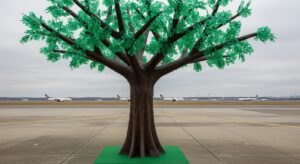
In certain high-risk areas such as airports, power plants, and highways, encouraging bird nesting in natural trees can be dangerous.
In such cases, plastic trees are used as safe substitutes, providing visual greenery without attracting birds.
This reduces the risk of bird strikes with airplanes or accidents caused by wildlife near dangerous zones.
♻️ 8. Extending the Life Cycle of Plastic Waste
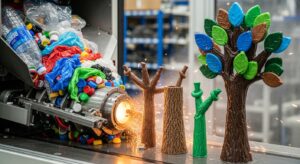
Each plastic tree represents hundreds or even thousands of reused plastic items.
Instead of being discarded after a single use, plastics are reshaped into something durable.
This contributes to the circular economy, where waste is repurposed again and again, slowing down the destructive cycle of overproduction and waste accumulation.
🎨 9. Artistic and Cultural Installations
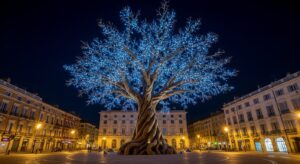
Artists around the world are using plastic trees as a medium for cultural expression and eco-art. These installations often highlight the beauty of nature while underscoring the ugliness of pollution.
For instance, giant plastic tree sculptures made from discarded bottles have been displayed in public squares as a stark reminder of human consumption habits.
🏡 10. Home and Office Décor

Plastic trees are also popular in interior design. From small desktop plants to large indoor artificial trees, they bring greenery to homes and workplaces without requiring care.
More importantly, many designers are now incorporating upcycled plastic into decorative trees, giving eco-conscious homeowners the chance to support sustainability while enhancing aesthetics.
🌍 Final Thoughts
Plastic trees are not meant to replace natural forests; nothing can substitute the ecological power of real trees. Instead, they serve as symbols of innovation and sustainability, showcasing how human creativity can turn waste into something purposeful.
From solar-powered energy generators to educational art installations, plastic trees remind us that solutions to our environmental crisis often come from thinking outside the box. The journey “from trash to trees” is a hopeful example of how we can reshape our future: one recycled bottle at a time. 🌱♻️✨
🌳 FAQs About Plastic Trees
1. 🌱 What exactly are plastic trees?
Plastic trees are artificial structures designed to look like real trees. They are often created from recycled plastic materials and can serve purposes ranging from decoration and landscaping to energy generation and environmental awareness.
2. ♻️ How are plastic trees made?
Plastic trees are usually made from repurposed plastic waste such as bottles, bags, and packaging materials. These items are cleaned, melted, and reshaped into parts that resemble leaves, branches, and trunks. Some versions also integrate metal and solar panels for added functionality.
3. 🌞 Can plastic trees produce oxygen like real trees?
No, plastic trees cannot perform photosynthesis and therefore don’t release oxygen. However, some models, such as solar plastic trees, provide environmental benefits by generating renewable energy instead.
4. 🏙 Why are plastic trees used in cities?
In crowded urban areas with little soil or high pollution, natural trees often struggle to survive. Plastic trees are used as low-maintenance substitutes to provide shade, beautify spaces, and symbolize greenery where real plants cannot thrive.
5. 🎄 Are plastic trees eco-friendly?
It depends on their use. While they don’t replace natural trees, plastic trees can be eco-friendly if they are made from recycled plastic waste, help raise awareness, or replace disposable decorations like single-use festival décor.
6. 🔋 What are solar plastic trees?
Solar plastic trees are innovative structures where “leaves” are replaced with solar panels. These trees generate renewable electricity to power streetlights, charge devices, or provide community energy solutions in both cities and villages.
7. 🦜 Do plastic trees attract wildlife?
Generally, plastic trees don’t attract wildlife like birds or insects because they lack natural food and shelter. In some cases—such as near airports—this is a safety advantage, since it prevents bird strikes.
8. 💧 Do plastic trees require maintenance?
Plastic trees require far less care than living trees. They don’t need water, fertilizer, or pruning, but they may need occasional cleaning to remove dust or repair if parts are damaged by weather.
9. 🎨 Where can we see plastic tree installations?
Plastic tree installations can be found in:
-
Public parks and eco-parks 🌍
-
Schools and museums (as educational exhibits) 📚
-
Shopping malls, airports, and highways (for landscaping) 🏙
-
Festivals and events (as decorative displays) 🎉
10. 🌍 Can plastic trees replace real trees?
No plastic trees can never replace the ecological importance of real trees, which provide oxygen, absorb carbon dioxide, and support wildlife. Plastic trees should be seen as supplements or symbolic solutions, not as alternatives to reforestation.